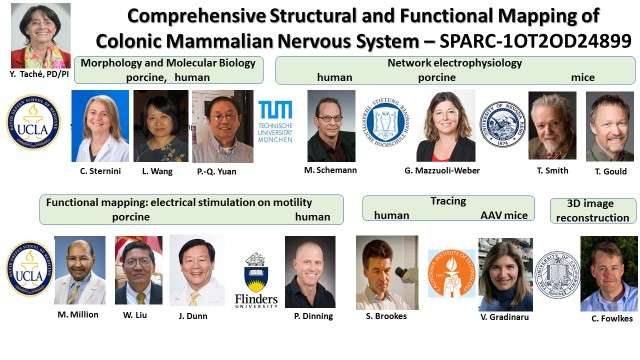SPARC
SPARC: Comprehensive structural and functional mapping of mammalian colonic nervous system
Overview
Stimulating Peripheral Activity to Relieve Conditions (SPARC) is a new NIH program to map peripheral nerves that control organ function. Our recently funded SPARC consortium grant focuses on the detailed structural and functional mapping of the intrinsic and extrinsic innervation of various regions of the colon in the pig as a mammalian model of human gastrointestinal physiology and human colonic tissues.
The knowledge of these nerve circuitries and activities will allow the targeting of selective neural structures to create more effective electroceuticals to treat colon diseases that are intractable to mainstay therapies. Conditions that may benefit from electroceutical treatment include inflammatory bowel diseases (IBDs), irritable bowel syndrome (IBS), postoperative ileus, chronic constipation and colorectal dysfunctions. In a translational study initiated by Bruno Bonaz MD, PhD, a former fellow of Dr. Taché, five out of seven patients with Crohn’s disease underwent clinical and endoscopic remission at six months of chronic cervical vagal stimulation. However, effective and safe electroceutical neuromodulation requires a detailed neural structural and functional circuitry mapping.
Teams
The grant brings together experts from four departments at UCLA and seven outside universities.
- Investigators at UCLA
- Drs. Million Mulugeta, Lixin Wang and Pu-Qing Yuan (Department of Medicine, Vatche and Tamar Manoukian Division of Digestive Diseases)
- Dr. Catia Sternini (Department of Neurobiology)
- Dr. Wentai Liu (Department of Bioengineering)
- Dr. Scott Friedman (Institute of Digital Research and Education)
- Principal investigators at the other universities
- Dr. James Dunn (Department of Surgery, Stanford)
- Dr. Viviana Gradinaru (Caltech)
- Dr. Charless Fowlkes (UC Irvine)
- Dr. Terrence Smith (University of Nevada-Reno)
- Dr. Michael Schemann (Technical University of Munich, Germany)
- Dr. Gemma Mazzuoli-Weber (University of Veterinary Medicine Hannover, Germany)
- Drs. Simon Brookes and Philip Dinning (Flinders University-Adelaide, Australia)

Approach
The understanding of afferent, efferent and intrinsic components of the peripheral nervous system controlling the colon at the neuroanatomical level requires the use of newly developed methodological approaches and tools. Among those to be performed at UCLA are:
- Immunohistochemistry with tissue clearing (CLARITY), high-resolution confocal microscopy, light sheet microscopy, 3D imaging (Drs. Pu-Qing Yuan and Catia Sternini)
- Genetically encoded functional tools for measuring or manipulating neuronal activity, and targeted expression of fluorescent proteins through adeno-associated virus vector to visualize neuronal processes within the colon (Dr. Lixin Wang)
- Molecular biology (laser microdissection combined with RT-PCR, RNAscope, RT-qPCR, microRNA targeting, and MILLIPLEX® multiplex assays (Drs. Pu-Qing Yuan and Ana Cristina Da Silva Gomes)
- Direct colonic tissue as well as selective colon afferent and efferent nerve neuromodulation using novel microelectrode array panels and cuffs; colonic tissue bio-impedance and luminal pressures monitoring using Millar and high-resolution fiber optic manometry (Drs. Million Mulugeta, Muriel Larauche and Wentai Liu)
Grants
- NIH OT2-OD024899. Comprehensive Structural and Functional Mapping of Mammalian Colonic Nervous System. PD/PI Y. Taché. 11/01/16-10/31/19
- NIH DK-41301 Digestive Diseases Center Grant, Animal Core. Y. Taché, Director, M. Million, Associate Director, L. Wang, Co-Investigator. 11/01/2014-10/31/2019
Publications
- Yuan PQ, Li T, Makurkar-Joshi S, Sohn J, Chang L, Taché Y. Three-dimensional imaging and computational quantitation as a novel approach to assess nerve fibers, enteric glial cells, mast cells, and the proximity of mast cells to the nerve fibers in human sigmoid mucosal biopsies from healthy subjects. Journal of Neuroscience Methods. Volume 418, June 2025, 110436
- Yuan PQ, Wu SV, Stengal A, Sato K, Taché Y. Activation of CRF1 receptors expressed in brainstem autonomic nuclei stimulates colonic enteric neurons and secreto-motor function in male rats. Neurgastoenterol Motil. 02 July 2021. doi.org/10.1111/nmo.14189
- Larauche M, Wang, Y, Wang PM, Dubrovsky G, Lo YK, Hsiang EL, Dunn JCY, Taché Y, Liu W, Million M. The effect of colonic tissue electrical stimulation and celiac branch of the abdominal vagus nerve neuromodulation on colonic motility in anesthetized pigs. Neurogastroenterol Motil. 2020 Jun 23; e13925. doi: 10.111/nmo.13925.
- Yuan P-Q, Wang L, Million M, Taché Y. CLARITY and three-dimensional (3D) imaging of the mouse and porcine colonic innervation. Neurogastro Motil. (in press).
- Larauche. M, Wang P-P, Dubrovsky G, Wang Y, Lo Y-K, Hsiang I, Dunn J, Liu W, Taché Y, Million M. Electroceuticals: Porcine model development to study the effect of neuromodulation on colonic motility. Neurogastro Motil. (in press).